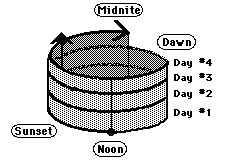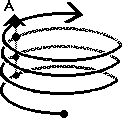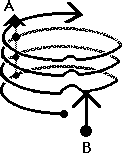
Home Science Page Data Stream Momentum Directionals Root Beings The Experiment
This notebook develops a slightly different concept of Time Ecology. The author is not attached to any idea of truth but instead explores the implications of Time Ecology. What is the theory of Time Ecology? What does it predict? Also explored is how Time Ecology differs from traditional interpretations of time.
The basic postulate or statement of Time Ecology is that different activities compete for different time slots. Just as daytime and nighttime creatures are somewhat separated in terms of their competition, so are daytime and nighttime activities. This implies that each time slot has a life of its own, taking into account that adjacent time periods bleed into each other or sometimes expand beyond their territory. The idea that each time slot has an existence of its own, gives rise to the idea that time moves vertically as well as forward. Nighttime moves vertically ahead somewhat independent of daytime in terms of activities.
The idea of competing activities yields the idea of independent existence for each activity. What does it mean for an activity to have an independent existence? Because each activity exists in a time slot, not independent from it, its characterization comes from how much it exists in this time slot. In Time Ecology activities are characterized by the density of their vertical time flows. In Ecological Time an Activity is characterized by its Vertical Time Density. (Its Horizontal Time Density is always 100% as long as it exists. Horizontal Time Density only has to do with existence and non-existence.)
Because Ecological Time has a vertical and horizontal component, Time becomes two-dimensional. See Diagram below. Remember that this is not a static cylinder. It is a growing spiral, moving ever upwards within its repeating cycles. If someone pulled on the line, it would turn into one line not many.

At every point on the line there is a forward momentum and an upward momentum. The forward momentum cannot be denied, because of our nature as beings in the space-time continuum. We have an inability to move forwards and backwards through time. The upward momentum, however, has strength but can be resisted. This upward momentum is the topic of this notebook.
Let us interpret the above graph from the perspective of the 24-hour day. A succession of days can be viewed as a continuous spiral with similar times hooked end to end. Midnight of Day 1 is connected to midnight of Day 2, which is connected to midnight of Day 3, and so on. Each point in the day acquires an upward momentum associated with the time of day. This is complemented by the ever-present forward linear momentum. This is demonstrated in the diagram below.

In terms of behavior, the theory of Time Ecology states that time does not only flow evenly forward, with one activity connecting continuously to the next. The theory of Time Ecology states that Time acquires a vertical momentum associated with behavior as well.
According to our postulates, time acquires two dimensions. What holds these dimensions together? Existence itself holds the horizontal dimension of time together. What is the glue that gives time its vertical component? What sticks an upper cycle of the spiral to a lower cycle in the spiral? The vertical dimension is held together primarily through Memory. Memory is the ability of a three-dimensional creature to pretend he is four-dimensional by mentally moving through time.
The idea of learning from experience is based upon the idea that the individual will come upon a similar experience again and will act accordingly. Purely physical objects don't learn from experience and instead always obey Newton's laws of motion. Live creatures can however learn from experience and thereby modify their behavior.
A Distinguishing feature between conscious Life and Matter is the aspect of memory. Matter doesn't use its memory of the past to make choices. A projectile following Newton's laws of motion has no memory of where it was yesterday and what it does today will only depend on Newton's laws of motion but will not depend upon what it experienced the last three Mondays. Consciousness is predicated upon Memory. Hence the response of conscious life's to its environment is integrally related to cyclical patterns based upon memory. Memory is a key ingredient in future responses.
Obviously some of these cycles only apply to the human species, i.e. week and month. What is the human glue that turns these artificial time limits into something real? What sticks one Monday to the next Monday? There are two factors: Memory and the ability to Compute. Many creatures have memory but humans have an incredible ability to compute which has given us an evolutionary advantage. {See Boredom Principle Notebook.}
With the concept of Ecological Time comes the idea of Time Density and Momentum. Time acquires a cyclical density independent of its linear component. Time must interpreted in more than one dimension. Normally time is given only one component. This is because one component is all that is necessary when dealing with physical objects, which are characterized by Dead Data Streams. (See Data Stream Momentum Notebook for a greater explanation.)
Our time spiral collects density over duration. In the linear component, time goes on, but doesn't collect density. Certain acute events, breaking bones, job loss, death, have a linear effect, continuous and forward. But even these acute events are inevitably subsumed by the cyclical spiral nature of time. After the pain has diminished and the healing has begun the broken bone only effects the life when the cycle comes up that is impacted by the broken bone, i.e. perhaps the sports cycle. The Sleep cycle is unaffected. Similarly the person who loses their day job is still able to participate in their normal evening and weekend activities, it is the workdays that are affected in a major way by the loss. This is when the emptiness can't be dashed. After the immediate grieving of a death to a loved one, the time the pain is most acute is when the cyclical nature of time returns to a spot where the deceased was regularly present. During other types of activities the pain quickly vanishes or is at least highly diminished.
While the linear component of time does not collect density, the cyclical component does. Each time the spiral comes around, the time spot accumulates vertical density. We think that the vertical density is related to series of measures, decaying averages, decaying standard deviations, and decaying impact scores. (See Decaying Measures Notebook for the supporting theory.)

Once a density is generated in any time cycle, it possesses a momentum, which ala Newton, wants to perpetuate itself. {See Data Stream Momentum Notebook for theoretical background.} Hence on an annual cycle, if a family has vacationed in the Yucatan every fall, once fall comes around the family collectively yearns to go to the Yucatan. The hardest time for an ex-addict of any kind is when the cycle comes around in his life that he used to participate in his addiction. The off times are easy. A Xmas density has been generated for most of us Westerners that is hard to suppress.
This section will discuss the implications of change in one-dimensional Linear time. Change in one-dimensional Linear Time has to with Conversion, i.e. major impacts. Change in two-dimensional Spiral Time has to do with frequent Repetitions.
Because Westerners are taught that Time is linear, consciously we don't acknowledge time density. Because of this we tend to believe in one-time conversions. If someone understands then one can immediately change, ala Freud. The diagram below shows this concept. Individual A moves along his life path. Individual B comes at him at right angles, impacting A with an immediate and complete religious, psycho-spiritual conversion. The world is saved. The lamb has returned to the flock. His conversion was instant, immediate and permanent.
Wrong! Would that life was so easy.

With a spiral view of time and time density, the impact is just as strong but only has an effect on the time immediately surrounding it. Not only that but unless the impact is repeated, its effect diminishes with each new cycle. Behaviorists are well aware of this phenomenon. They work on changing underlying cyclical patterns rather than focusing upon instant conversion.

With the ecological view of time change occurs through repetition and practice not through a one time impact. The Repetition or Practice is necessary to change the time momentum that is in place. Once the practice has momentum then it carries the individual along. This is the positive side of time momentum. It takes Will to change the Flow, which is the time momentum.
Back to our original example. If the extra hours freed up by reducing Waiting are consciously used directly for creativity, then Creative Time would increase. But this takes an effort of Will rather than an easy Flow. The Flow simply accentuates Time densities already in place while Will creates new time densities. Effort is required. Effort requires Will. (See Data Stream Momentum Notebook.)
In some strange ways this is the most controversial of all the postulates. Everyone believes in behavior. But most people don't think in terms of behavior separate from the source. Obviously for a behavior to exist it must have a source. But the postulate here is that this activity acquires an existence separate and independent of the source. This is not to say that the Source does not have an effect upon behavior. The Source has an effect on behavior and behavior has an effect upon the Source, but they also exist independently. My wife and I exist independently although we can have an effect upon each other.
If behavior exists independent of Source, how does it exist? It exists through Time this postulate asserts. What does this mean? Most things exist continuously through time without interruption. Those things that have an interrupted temporal existence don't really exist in every day thought. Anything that moves in and out of existence is brought into existence by a Source and so is linked to that Source as an attribute rather than having an existence of its own. The first postulate asserted an independent existence. This postulate asserts that these behaviors exist through time independent of continuity. How can they do that?
Activities don't exist continuously, but exist partially. They don't cover the whole day only part of a day. Their partial existence acquires Time Density.
The partial existence yields a Time Density, which has momentum. Because of this momentum the activity seeks to perpetuate itself. This momentum will carry the object forward unless another force acts upon it. Things that exist wholly, not partially, have 100% Time Density and therefore 100% Momentum. Activities have a partial existence, a partial Time Density, and a partial momentum. The partial momentum seeks to perpetuate itself.
Because partial time momentum is discontinuous, when it meets up with real momentum it evaporates. The real momentum of Death destroys all partial time momentums immediately, without effort, maybe a little twitching is all. Real Momentum always takes precedence over partial. Partial momentum guides real momentum, but does not dominate it.